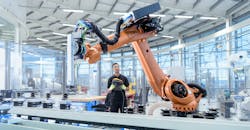Global Manufacturer Looks at Industry 4.0 Through COVID-19 Lenses
In many ways the pandemic has impacted not only how manufacturers operate, but also how they value their investments, especially in digital technologies. For many, COVID-19 has intensified the need for specific tools enabling operations in today’s reality. However, what specifically matters can depend heavily on an operator's individual environment and operational priorities.
Read on as Paul Baldassari, executive vice president of strategic programs and asset management with Flex Ltd., shares his insights on how the pandemic has shaped the global manufacturer’s operations.
Baldassari: The pandemic tested the maturity of the Industry 4.0 movement. When COVID-19 spread throughout the world, the ability to have real-time information at your fingertips for everything, from suppliers to the factory floor, empowered teams to operate at the same speed, if not faster.
In the factory, automation and robotics were instrumental in spreading the shop floor and keeping employees properly distanced. Augmented reality played a critical role in setting lines up quickly. And simulation was essential for virtually showcasing and making changes to factories, lines, and ramps. The industry proved that a lot of these advanced manufacturing technologies are ready for primetime.
However, we quickly learned that some of the promises of Industry 4.0 aren't as important in a post-pandemic world. For instance, the idea of customization gained strong momentum pre-pandemic. And while it's still significant for some markets, such as enterprise computing and communication, we've seen it's not nearly as important to consumers as initially thought. Our experience suggests that interface customization is essential for electronics, but people don't want to be overwhelmed making the decisions required for a truly customizable product.
IW: What advanced manufacturing technologies aren’t living up to the hype?
Baldassari: Two major advanced manufacturing technologies haven’t lived up to the hype yet: additive manufacturing and smart products.
Don't get me wrong. Additive manufacturing has been excellent for quickly prototyping tools, fixtures, and spare parts. But the promise that additive manufacturing could help high-volume production, or 3D printed parts, hasn't lived up to the hype. In some lower-volume manufacturing initiatives, such as aerospace, it's worked, but for high-volume or complex production, additive manufacturing has fallen short thus far. Further, additive manufacturing only yields roughly 80% of the material strength compared to a part produced by molding, milling, or other traditional methods. Additive manufacturing also requires expensive equipment and time-consuming post-processing in many applications.
The other technology that has not lived up to the Industry 4.0 hype is highly configurable smart products. There was a belief that every product would define its journey through the manufacturing process, but this requires a lot of strategy and design. There's a lot more untapped value in investing and pushing intelligence on the factory floor than the actual product during manufacturing.
IW: Any technologies you feel are not getting enough attention?
Baldassari: Simulation is not getting nearly enough attention. Most companies have dipped their toes into simulation, but we've made a big commitment to it at Flex. There's a real opportunity for growth in a post-pandemic world.
The power of simulation is that it drives the upfront conversations organizations must have externally with customers and internally with staff before producing a product. How will the factory be set up? How will the product flow through the line? Traditionally, executives and customers would fly to a factory to walk the floor and physically see how products would roll off the lines. Changes to the line or factory setup could take months. And if it didn't work? You're back to square one, reverting to the original layout, wasting time and money.
Simulation provides a virtual view of the factory for all stakeholders, showcasing what the factory and line looks like and highlights the machine view to identify and troubleshoot issues proactively. If a change is needed, it's as simple as clicking a mouse and running a new simulated version with additional logic layers. Once the line view is set up, businesses can create a simulated view of the material flow, which helps look at equipment yields. Manufacturers can also make a yield prediction and see if a machine or process doesn't work. Once you have that information, you can address what a failure means for your full manufacturing process, areas you need to fix, and gaps in throughput. You can also simulate the inventory view, ensuring the setup generates the right throughput without creating a stockpile in the factory.
Something else that has been incredibly helpful is simulating the employee view, especially during the pandemic. This process helps businesses understand the factory and how people utilize equipment, ensuring it's designed in an ergonomic way to promote safety and efficiency while preventing injuries and keeping employees socially distanced.
Travel restrictions hampered 2020 and will be a big part of 2021. Before COVID, everyone thought simulation was challenging. It's not easy, but we've completed more than 200 simulation projects in the last two years at Flex and saved our customers a lot of time, money, and stress. Our management has extensively utilized simulation because it's essential for support functions to connect to factories. We've been together with our people walking the shop floor virtually. It also helps our customers make sure they have a good feeling about how we secure their product, implement their new product, and apply advanced technology to support them in this difficult time.
IW: Any insights into how an organization can determine which digital technologies make the most sense for their operating environments?
Baldassari: The biggest challenge for any organization is often getting started. The most crucial step is to take stock of your current environment. Where do you need help? Are factory employees wasting time on routine and repetitive tasks? Maybe investing in automation and robotics is the right step.
Once you've been able to address the areas you need help, the next step is to get started. Start small on one project, assess the results, and then scale to additional projects. Once businesses gain confidence and see positive results, it's easy to build momentum and make investments in other digital technologies that modernize and improve the manufacturing process.
IW: Any Industry 4.0 pitfalls you have seen that can actually hamper production?
Baldassari: One of the key tenants behind Industry 4.0 is having the advanced manufacturing technology to extract real-time information and make accurate decisions in real-time. However, businesses experience data overload when they aggregate and analyze data from thousands or millions of feeds, which can lead to a delay in decision making.
One of the most common pitfalls is making decisions based on outdated information. Whether from an internal source or working with a partner, flexible interfaces become incredibly important. Real-time data must get to the right decision-makers fast, so they make good decisions quickly. If you're not going to utilize the data in this manner, it might make sense to allow the equipment to collaborate and automatically decide for itself. That way, you're not applying new fixes to old problems.
IW: How has the industry benefited from adopting elements of Industry 4.0?
Baldassari: It comes down to making better decisions based on current information. Whether you're talking simulation, automation, machine to machine (M2M) communication, or virtual reality, businesses are finding that it's easier to collect vast amounts of data that weren't accessible before.
Digitizing processes and coupling them with advanced analytics empowers employees to gain deeper insights, run tests, add innovation, and make real-time decisions that keep manufacturing operations running smoothly.
For instance, with a digital supply chain, manufacturers can immediately see when they have a shortage and where they can source inventory. Or on the shop floor, energy consumption data can identify when a piece of equipment is about to wear out so you can order a replacement or schedule maintenance. Another great example is automation: high-speed cameras can detect if a line starts to wear out or if you need to address a specific section. These examples showcase how vital data is when properly harnessed.
IW: Which elements are benefiting the industry the most and can be associated with improved business outcomes?
Baldassari: It depends on the business need and what an organization is looking to manufacture. As an example, Flex recently leveraged simulation in 2020 and created a digital twin of a factory to optimize the manufacturing of a medical device for a customer.
In this case study, the device model was reiterated hundreds of thousands of times, which enabled the team to quickly run "what if" scenarios and test out numerous variables and constraints to see what best fit the process. Using simulation, an approach that otherwise would have taken three months to complete was reduced to only three weeks.
On the demand front, the customer was looking for 8 million units per quarter. Manually, the scheduling team was averaging around 5.5 million. Using simulation over a few days, the scheduling was optimized to produce 8.1 million units.
And when it comes to efficiency, simulation directly impacted the output, increasing one station by 69.8% and another station by 16.75%. Additionally, simulation was able to reduce change over time by 27 hours.
This project reaped multiple benefits for the customer by implementing simulation, including time savings, operational benefits, technology benefits, business benefits, and project management benefits.
About the Author
Peter Fretty
Technology Editor
As a highly experienced journalist, Peter Fretty regularly covers advances in manufacturing, information technology, and software. He has written thousands of feature articles, cover stories, and white papers for an assortment of trade journals, business publications, and consumer magazines.

